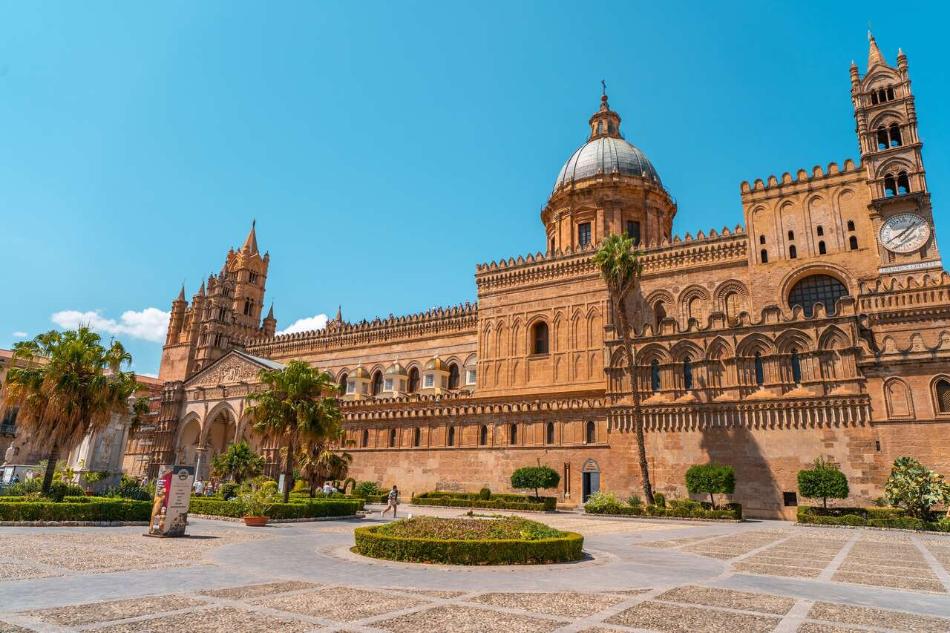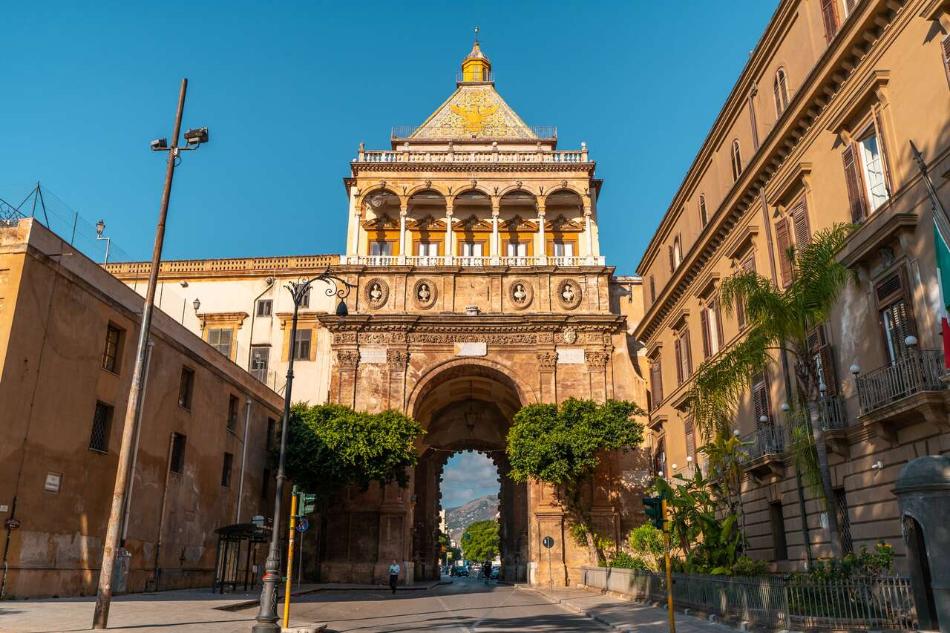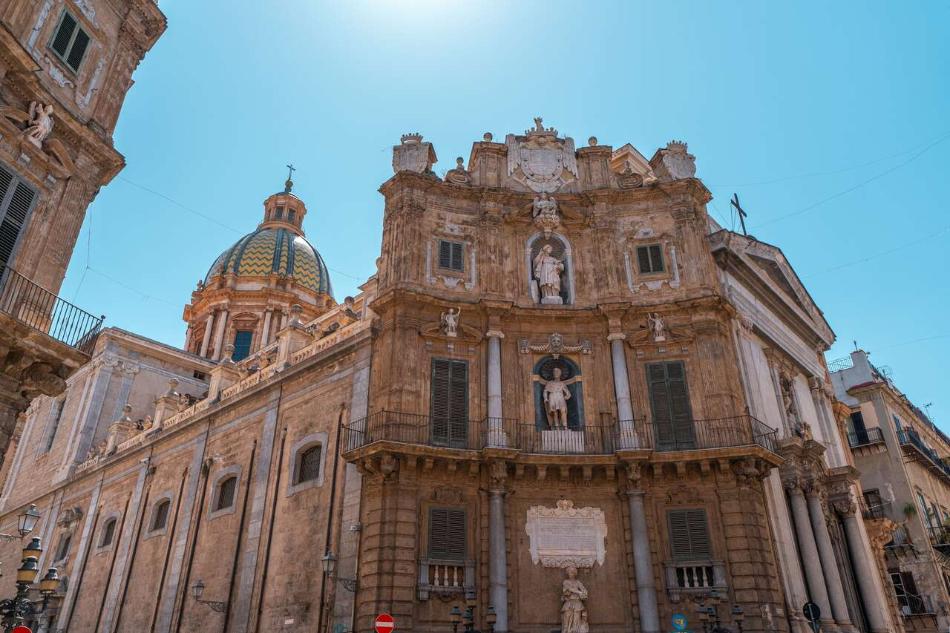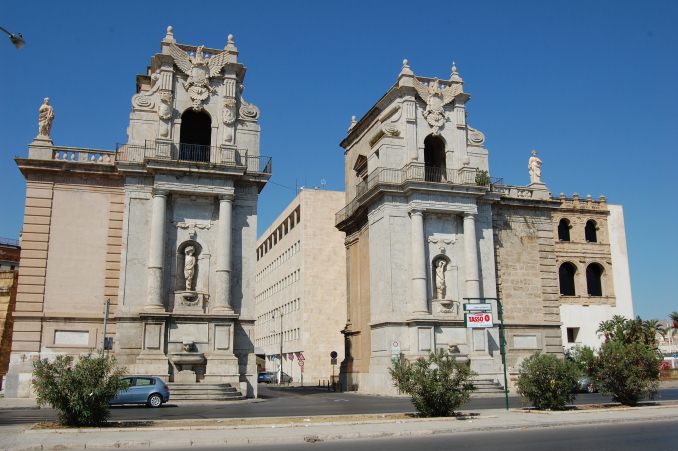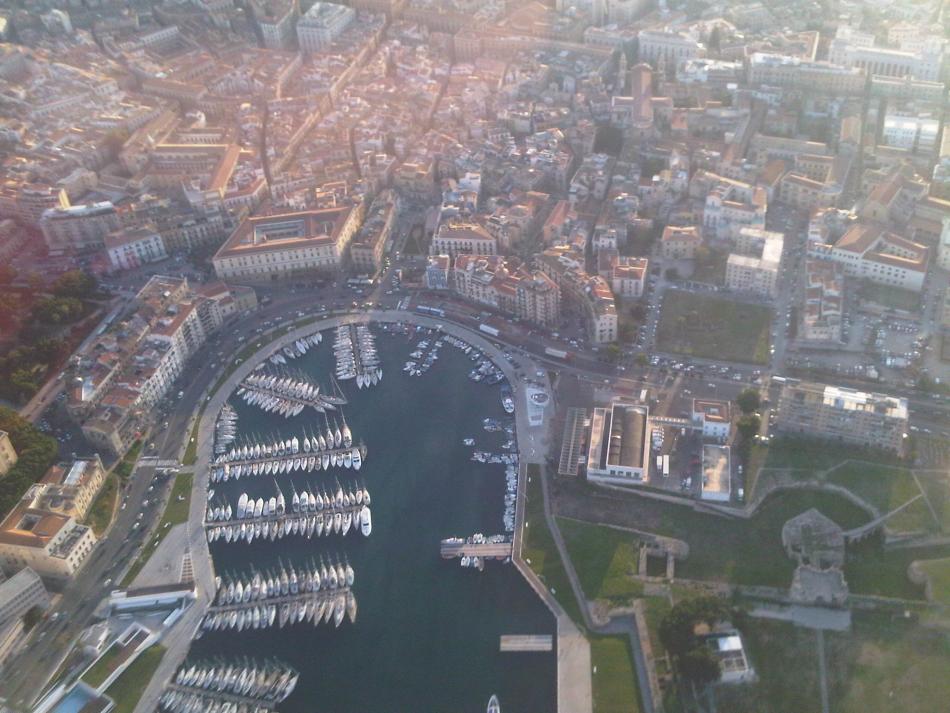Path of the chariot
The traditional triumphal procession
This traditional event is one of the most extraordinary and engaging moments of the year for Palermo, when the statue of Santa Rosalia is carried in procession through the streets of the city, attracting thousands of devotees and tourists.
Every year, the Carro della Santuzza is prepared with meticulous care, transformed into an authentic travelling jewel.
The organisers are passionately dedicated to creating increasingly evocative stage design to guarantee an unparalleled show.
The procession is an explosion of plays of light that liven up the Palermo night.
Acrobatic dances and artistic performances add emotion and beauty to this unique show.
And don't forget the grand finale, with fireworks that light up the sky, creating a magical and festive atmosphere.
The Festival of Santa Rosalia is a moment in which tradition and folklore intertwine to honour Santuzza.
For the people of Palermo, it is an opportunity to rediscover their collective identity and to celebrate the city's cultural roots.
For tourists, it is a unique opportunity to immerse themselves in the culture of Palermo and discover its ancient traditions.
Preparations are underway for the 400th Festival of Santa Rosalia, and while we wait to hear all the news, let's retrace the stages of the triumphal procession of 2023.
The carro is stopped in front of the cathedral, but in the meantime, a dramatization of the arrival of the epidemic in Palermo is staged in Piano di Palazzo Reale, with the docking of the plague-stricken vessel. A story begins made up of images, lights, sounds, words and theatrical actions, and a great deal of videomapping. The plague victims are acrobats suspended between life and death, who will climb the facade and enter through the openings in it, in a true assault on the Norman palace. The incipit of the narration is Rosalia's dream, amidst apocalyptic visions. At the end of the first scene, a procession of trumpets and drums playing a melancholic tune heads towards the MoonCarro, darkened and pulled by ethereal and angelic figures towards the cathedral, along with the statue of the veiled saint.
Palazzo dei Normanni
The residence of the Norman royals, part of the UNESCO Arab-Norman route, is now the seat of the Sicilian Parliament. The result of successive renovations of the oldest fortification in the city, it preserves elements ranging from the Punic era to the nineteenth century. Do not miss the Palatine Chapel, with Byzantine mosaics on a gold background and the meticulously decorated wooden ceiling in Middle Eastern style; the Stanza di Ruggero, an extraordinary testimony of the original appearance of the building, and the nineteenth-century apartments, which hark back to the residence of the Bourbon royalty. Behind the building stands Porta Nuova, one of the sixteenth-century entrances to the city, while in front of it stretches the wide Piazza della Vittoria, with all the exotic charm of its soaring palms.
The Cathedral, La Chiesa Maggiuri as it was called in the 1600s, is the place where the bones of the Saint are kept, and this is why it has become the place where dreams begin. From the penitential darkness of the nightmare, the light becomes dazzling. Here the scene changes, Geronima the Gattuta dreams, and Rosalia appears. The youth orchestras and the Children's Choir of the Teatro Massimo conjure up golden visions linked to the projections on the porch and transept, conveying a sense of rebirth, of waking up from a nightmare. Light Painting and videomapping on the Cathedral draw a multitude of angels who descend from the roofs, light acrobats surrounding the still darkened Carro. At the top is a beam of light, directed towards the Triumphal Carro, which lights up to reveal the statue of the Saint. The Cassaro is lit up in white, and the Procession advances. A live action show by a group of students from the Academy of Fine Arts.
Cathedral of Palermo
With its harmonious combination of styles, the Cathedral is probably the most scenic building in the city. Preceded by a large churchyard dominated by a splendid marble statue of Santa Rosalia, it brings together Norman apses, a fifteenth-century portico, an eighteenth-century dome and small domes, and a bell tower built in the nineteenth century in Neo-Gothic style, considered to be among the most beautiful in Italy. Inside are the royal and imperial tombs, with the sepulchres, among others, of King Roger II and Emperor Frederick II, and the Chapel of Santa Rosalia
containing her silver reliquary. The visit includes the crypt with the treasure and an opportunity to climb up to the roof. On the other side of via Matteo Bonello stands the fifteenth-century Archbishop's palace, now housing the precious Diocesan Museum, with an entire room dedicated to the patron saint. Also not to be missed is the nearby Palazzo Asmundo (via P. Novelli 3), a repository of refined art, with frescoes and stuccoes framing the collections of ceramics, porcelain, paintings, ancient geographical maps and much more.
The dramatic testimony of the plague victims, taken from the historical archives, appear along this first part of the Cassaro, thanks to the use of an audio system that winds along the entire route of the procession. A soundtrack of words and musical rhythm renders the feeling of supplication and prayer while awaiting arrival in the heart of the city, at the Quattro Canti.
The Cassaro
Among the aristocratic residences overlooking the street in Palermo, Palazzo Drago Ajroldi (at number 382) stands out for its interesting harmony of eighteenth- and nineteenth-century architecture and decorations. It is open to the public and hosts regular exhibitions and events. A little further on, a few steps from the Quattro Canti, Piazza Bologni is one of the city's oldest squares, dominated by the sixteenth-century statue of Charles V and surrounded by beautiful buildings such as the eighteenth-century Alliata di Villafranca, now an interesting museum still containing the original furnishings and decorations (the remarkable picture gallery includes a Crucifix by Antoon Van Dyck, painted in 1625, perhaps as a votive offering for Santa Rosalia). Opposite the statue of the emperor is the entrance to Palazzo Belmonte Riso, which became home to the Sicilian Museum of Contemporary Art in 2009 following extensive renovations.
Thus we arrive at the Teatro del Sole, the beating heart of the city, which marks the wait for the relics the following day. Waiting for the carriage will be a celestial vault, which lights up with the arrival of the great Moon and the Saint holding out a white lily, the symbol of her purity. A triumph of aerial figures and flying acrobats will flood the skies of the Quattro Canti, with a piano suspended in the centre to accompany the entrance of the Carriage, which is positioned in the centre of the city. When the mayor (who will get on the cart with a representative of the Hope and Charity Mission founded by Biagio Conte), cries Viva Palermo e Santa Rosalia, a swirling and extraordinary cascade of petals will flood Piazza Vigliena, amidst lights and clouds of white smoke, giving tangible form to Rosalia's dream.
Piazza Vigliena
Built starting in 1611, Piazza Villena, which everyone knows as I Quattro Canti, was designed to add prestige to the intersection between the two main roads of the time: the Cassaro, now Corso Vittorio Emanuele, and Via Maqueda. The monumental backdrops, a set of Baroque fountains and statues, are provided by the facades of the buildings facing them: the church of San Giuseppe dei Teatini and the Guggino Bordonaro, Costantino (occasionally open to visitors for exhibitions and events) and Starrabba di Rudinì palazzi. Behind the Quattro Canti is Piazza Pretoria, with its spectacular sixteenth-century fountain, and the Palazzo delle Aquile, the Town Hall, and Palazzo Bonocore. The latter, entrusted to CoopCulture, will soon host a multimedia museum.
From Piazza Vigliena to via Roma. The miraculous city
The procession resumes along the entire route of the Cassaro with the litany of voices heard previously, but this time sharing the testimonies of the miraculously cured, taken from the historical archives. Now the soundtrack is a transcendent litany, and the rhythm of the music conveys a feeling of liberation, but also of waiting for the promise to become actual liberation from evil.
The golden paradise
At the crossroads between the Cassaro and via Roma, an ethereal figure sings an ode to Santuzza. For a brief but intense stop, the crossroads hosts a column of light and vapour that stands out against the sky, while the song spreads throughout the Cassaro before the procession resumes its journey.
From via Roma to Porta Felice. The city in celebration
After the story of the dream, the drums and trumpets, which at the beginning of the procession scored the funereal passage of the plague, now play with joy and cheer: we go to the sea, to chase away the evil and return it to where it came from.
Piazza Marina
With its beautiful marble fountain and, to the right, Porta Felice, the triumphal entrance to the city built between the sixteenth and seventeenth centuries, the large Piazza Marina opens up, a historic urban open space surrounded by ancient palazzi. The Steri stands out, one of the most historic buildings in the city, originally the residence of the powerful Chiaramonte family, who had it built in the fourteenth century. Vice-royal headquarters of the Tribunal of the Inquisition – which held its fearsome autos-da-fé right in the square – and of the Customs Office, it now houses the offices of the University Rectorate. Inside the building (where services are provided by CoopCulture) you can visit the prisons of the Inquisition, the great hall with its original fourteenth-century decorated ceiling, and the room intended for the exhibition of the Vucciria, painted by Renato Guttuso. At the centre of the square is the verdant Villa Garibaldi, dominated by a monumental Ficus Magnolioides, one of the largest trees in Europe.
The Moon – Carro is welcomed at the Teatro Massimo, as the smiling figures of Biagio and Pino come to life and speak on the two pylons of Porta Felice: they will take on the task of protecting Palermo with Rosalia, symbolically bringing together all the blessed who have lived in the land. As the carro passes through the gate, a fan of lights gives the city a sign that it has overcome its nightmare. The carro will pass through Porta Felice and stop at the Palchetto della Musica, preceded by a traditional band, closing with the traditional hymn to Santuzza.
Piazza Marina
With its beautiful marble fountain and, to the right, Porta Felice, the triumphal entrance to the city built between the sixteenth and seventeenth centuries, the large Piazza Marina opens up, a historic urban open space surrounded by ancient palazzi. The Steri stands out, one of the most historic buildings in the city, originally the residence of the powerful Chiaramonte family, who had it built in the fourteenth century. Vice-royal headquarters of the Tribunal of the Inquisition – which held its fearsome autos-da-fé right in the square – and of the Customs Office, it now houses the offices of the University Rectorate. Inside the building (where services are provided by CoopCulture) you can visit the prisons of the Inquisition, the great hall with its original fourteenth-century decorated ceiling, and the room intended for the exhibition of the Vucciria, painted by Renato Guttuso. At the centre of the square is the verdant Villa Garibaldi, dominated by a monumental Ficus Magnolioides, one of the largest trees in Europe.

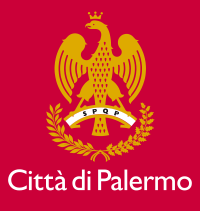


Progetto cofinanaziato dall'Unione Europea - Fondi Strutturali e di Investimento Europei - Programma Operativo Città Metropolitane 2014-2020



